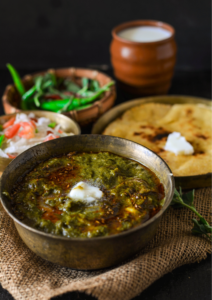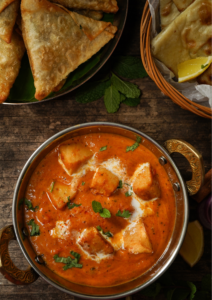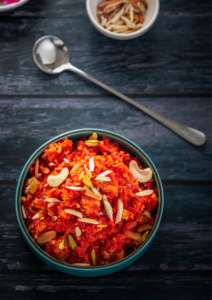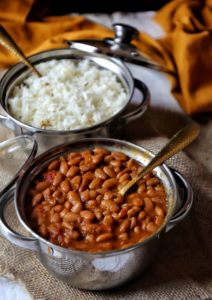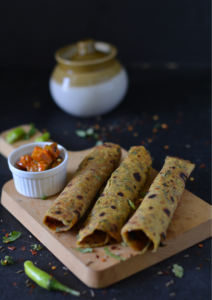As winter unfolds its chilly embrace, the season beckons culinary exploration with an array of comforting and flavor-packed dishes that warm both body and soul. From hearty soups to aromatic spices, winter cuisine brings a unique charm to the dining table. Here, we present five must-try dishes that capture the essence of winter indulgence, inviting you on a culinary journey filled with warmth, richness, and the distinctive flavors that make the colder months a gastronomic delight. Embrace the season’s bounty and savor these winter specialties that promise to leave you with a taste of comfort and satisfaction.
Makki di roti and Sarson da Saag
Sarson da Saag with Makki di Roti is a classic Punjabi dish that embodies the rich flavors of mustard greens and the rustic charm of maize flour flatbreads. To prepare the Sarson da Saag, start by boiling a bunch of mustard greens and half a bunch of spinach until tender. Afterward, blend them into a coarse paste, capturing the essence of the greens. In a pan, sauté finely chopped onions and green chilies in ghee until they become aromatic. Introduce ginger-garlic paste to the mix, enhancing the dish’s depth of flavor. Incorporate the vibrant green paste into the sautéed ingredients, allowing the amalgamation of flavors. To achieve the desired consistency, add maize flour and salt, cooking until the mixture thickens and attains a delightful texture. Complementing the Sarson da Saag, Makki di Roti, the maize flour flatbreads, are prepared by kneading maize flour with warm water and salt. Form the dough into small balls and roll them into flatbreads. Cook these rustic flatbreads on a griddle until they boast a golden-brown hue, providing the perfect accompaniment to the robust Sarson da Saag. This combination captures the heartiness of winter and the authentic flavors of Punjabi cuisine, making it a soul-warming delight for your winter table.
Paneer Tikka Masala
Paneer Tikka Masala is a delectable Indian dish that seamlessly combines the succulence of grilled paneer with a rich, aromatic tomato-based gravy. To embark on this culinary journey, start by marinating 250g of cubed paneer in a flavorful blend of yogurt, ginger-garlic paste, red chili powder, turmeric, and a pinch of salt. Allow these vibrant spices to infuse the paneer, creating a symphony of flavors.
Next, grill the marinated paneer until it attains a glorious golden hue, capturing the essence of smoky perfection. In a pan, melt a generous amount of butter, introducing the warmth of garam masala to the sizzling concoction. The addition of tomato puree transforms the base into a luscious gravy, with the aromatic spices dancing harmoniously.
As the tomato puree cooks down, patiently await the moment when the rich, flavorful oil separates from the mixture—a sign that the magic is unfolding. Then, gently add the grilled paneer to the simmering pot, allowing the marriage of textures and tastes. The dish comes together in a delightful simmer, bringing forth the irresistible combination of tender paneer and the sumptuous tomato gravy.
Finally, garnish your Paneer Tikka Masala with a sprinkle of fresh coriander, adding a burst of freshness and a visual feast to this already indulgent creation. Whether served with steaming rice or warm, fluffy naan, this dish stands as a testament to the artistry of Indian cuisine, capturing the essence of winter warmth in every flavorful bite.
Gajar Ka Halwa
Gajar Ka Halwa, or Carrot Halwa, stands as a beloved winter treat in Indian households, epitomizing the richness of seasonal ingredients. To embark on this sweet culinary journey, begin by grating 1 kg of fresh carrots, a vibrant and hearty base that sets the stage for a decadent dessert.
In a symphony of flavors, cook the grated carrots in a liter of milk until they soften and absorb the creamy essence, allowing the milk to gracefully evaporate. This slow-cooking process ensures that the carrots meld seamlessly with the milk, creating a luscious and velvety texture.
As the carrots reach a delightful tenderness, introduce the sweetness of 1 cup of sugar and the richness of 1/2 cup of ghee into the mix. Allow these elements to weave together, gradually thickening the concoction into a sumptuous halwa that embodies the essence of winter indulgence.
To elevate the texture and add a delightful crunch, sprinkle in a quarter cup of chopped nuts, such as almonds and cashews. These nutty additions bring a delightful contrast to the softness of the halwa, creating a harmonious blend of textures.
No Indian dessert is complete without the aromatic touch of cardamom. Infuse the halwa with the warm, fragrant notes of cardamom powder, adding a final layer of complexity to the already flavorful medley.
Stir the halwa well, ensuring that every spoonful is a celebration of winter’s bounty. Serve this Gajar Ka Halwa either warm or at room temperature, savoring the rich flavors that make it a quintessential winter delight and a sweet tribute to the season.
Rajma Chawal
Rajma Chawal, a beloved North Indian classic, is a wholesome and flavorful dish that marries the earthiness of kidney beans with aromatic spices, creating a comforting and satisfying meal. To embark on the culinary journey of Rajma Chawal, begin by soaking 1 cup of kidney beans (rajma) overnight, ensuring their tenderness when cooked.
Boil the soaked kidney beans until they reach a delightful tenderness, offering a perfect canvas for the forthcoming infusion of flavors. In a pan, sauté finely chopped onions, cumin seeds, and ginger-garlic paste, establishing the foundation of the dish with a symphony of aromatics.
Add the velvety richness of pureed tomatoes to the sautéed mixture, along with a teaspoon each of red chili powder, and garam masala, infusing the curry with layers of warmth and spice. Allow these elements to harmonize as the tomato puree cooks down, creating a luscious base for the kidney beans.
Introduce the boiled kidney beans into the aromatic curry, letting them absorb the flavors and meld seamlessly with the spices. Simmer the curry to allow the beans to soak up the richness of the sauce, creating a hearty and satisfying dish.
Garnish the Rajma Chawal with a generous sprinkle of freshly chopped coriander, adding a burst of freshness to the dish. Serve this delightful kidney bean curry alongside steamed basmati rice, creating a symphony of textures and tastes that epitomize the comfort and heartiness of a quintessential North Indian meal. Rajma Chawal not only warms the soul but also celebrates the culinary traditions that make it a cherished favorite during the winter season.
Methi Thepla
Methi Thepla, a cherished flatbread in Gujarati cuisine, showcases the delightful blend of whole wheat and gram flours, infused with the distinct flavor of fresh fenugreek leaves (methi). To craft this delectable dish, commence by combining 2 cups of whole wheat flour and 1/2 cup of gram flour in a bowl. Add the aromatic touch of chopped fresh fenugreek leaves, imparting a unique and earthy flavor to the dough.
Incorporate a tablespoon of yogurt, which not only adds a hint of tanginess but also contributes to the softness of the theplas. Introduce a teaspoon of red chili powder, 1/2 teaspoon of turmeric powder, and salt to taste, creating a harmonious blend of spices that elevates the overall taste.
Gradually knead the mixture into a soft dough, adding water as needed to achieve the desired consistency. Form small, uniform balls from the dough, each promising a delightful thepla.
Roll out each ball into a thin, round flatbread, ensuring an even thickness for consistent cooking. Cook these theplas on a griddle, using ghee for a touch of richness and to enhance the overall flavor profile.
The result is a stack of Methi Theplas, each boasting a perfect balance of textures and the distinctive taste of fenugreek leaves. Enjoy these theplas warm, perhaps paired with yogurt, pickles, or a dollop of ghee, for a truly satisfying and flavorful experience that pays homage to the culinary traditions of Gujarat. Methi Thepla not only provides a delicious accompaniment to winter meals but also embodies the warmth of homemade comfort food.

